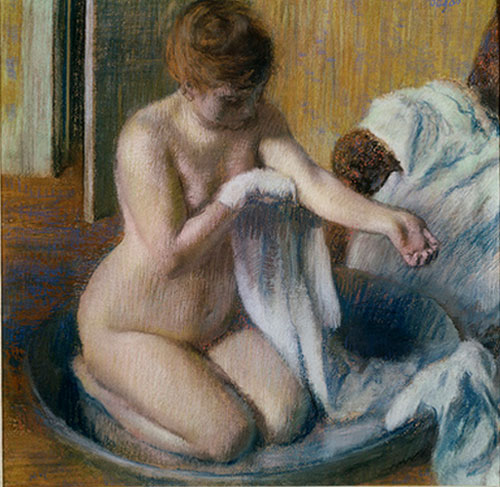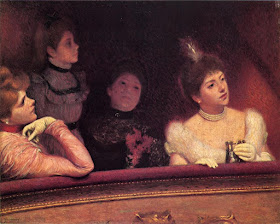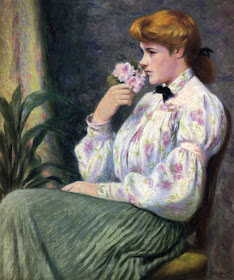 |
Last Saturday, on the last day of 2011, I went on an excursion to the Milwaukee Art Museum. Although I had already visited "Brew Town" a few times during the year, as tends to be typical, and never need an excuse to see--in Santiago Calatrava's Quadracci Pavilion addition--the most beautiful building built in America this century, my impetus was an exhibit called Impressionism: Masterworks on Paper.
In my own head, it was notable that I had visited the Louvre in Paris on the first day of December. And though over the three days prior, I had seen wondrous works of Impressionism at London's National Gallery and Courtauld Gallery, especially in not having time to once again visit the Musee d'Orsay--Paris' great repository of Impressionism--it seemed rather apropos to see this exhibit on the last day of December. Some kind of abstract symmetry or something.
The exhibit, which opened in October, closes this Sunday, so I won't write a full-fledged review, but highly recommend that those so inclined get to it if possible.
On the Seth Saith @@@@@ rating scale, I would award the exhibit @@@@, as focusing primarily on drawings, I can't say that it was quite as exciting as roomfuls of paintings by the masters of impressionism, but it was extremely worthwhile in providing complementary insight.
I enjoyed seeing drawings--from black line drawings by Seurat that looked nothing like his paintings to full-fledged pastels by Degas (as at left) that were just as beautiful as his oils--by almost all of Impressionism's main superstars. Besides the aforementioned, these included Monet, Manet, Renoir, Cezanne, Van Gogh, Toulouse-Lautrec, Pissarro, Gauguin, Morisot, Cassatt and Signac.
Those who won't make it to Milwaukee may derive value from viewing the exhibition website or an even more in-depth teacher's resource that I stumbled upon.
I should mention that in addition to about 8 galleries of drawings, there were a few paintings, mainly from the museum's permanent collection, but also including this lovely Renoir, borrowed from Pittsburgh's Carnegie Museum of Art after the MAM won a gentleman's wager when the Packers beat the Steelers in the 2011 Super Bowl. And though it's not in the exhibit, but rather the MAM's main collection, this painting by Caillebotte is an impressionistic masterwork that shouldn't be missed.
Beyond seeing many excellent and informative drawings--plus a few paintings--by Impressionists (and technically, post-Impressionists) with whom I have long been familiar, even if to a lesser degree such as Redon and Boudin, I was struck by the number of exquisite works by artists whose names I didn't recall.
I have never been an art scholar, but long an avid amateur aficionado, fortunate to have visited many great art museums around the world. Though my memory isn't what it used to be, I have come to know of hundreds of artists across many eras and genres, with the Impressionists long being among my favorites.
So for an Impressionism exhibit in Milwaukee to have among Monet, Manet, Renoir, Pissarro, Van Gogh, etc., works by at least four of their contemporaries whose names--Jean-Louis Forain, Armand Guillaumin, Eva Gonzales and Federico Zandomeneghi--didn't ring a bell, was surprising, but also intriguing and even, in a curiosity-sparking sort of way, exhilarating.
Of the "unknowns," the works of Zandomeneghi--including "At The Fireplace" at right (photo not by me)--were my favorites, and even outshone some of his more famous compadres.
The picture at the top of this piece, titled "Place d'Anvers, Paris" from 1880, is not part of the Milwaukee exhibit. Perhaps that's because it is a painting, not a drawing, but of the relatively sparse array of Zandomeneghi's works that I could find online--this is the best gathering--most seem to be held in private collections, not museums.
Federico Zandomeneghi does have a Wikipedia entry, but it too is very scant, and there are seemingly no English-language books about him I can buy or borrow.
As you might deduce from his name, he was Italian, born in Venice in 1841, but moved to Paris in 1874 and remained there until his death in 1917. He became a close friend of Edgar Degas and his works were included in four of the groundbreaking Impressionist exhibitions (1879, 1880, 1881, 1886). So he seemingly wasn't painting in complete obscurity, unknown in his lifetime.
I have to imagine that in Paris around 1870-1890, there must have been hundreds or thousands of Impressionist-type painters who just weren't worthy of being shown at the Salon (the main exhibition), or if they were, have been forgotten by history, deemed lesser than the legends. After all, not just everyone could have the talent of Renoir and Seurat, et. al.
You've got to figure that beyond the 10-20 Impressionists (and post- and neo-Impressionists) that remain widely revered, the next best 100 or so still had to be blow-your-mind good. Perhaps they didn't become adored by savvy collectors at the time, or by museum curators years later, and maybe their paintings remain hidden in some attic. Who knows?
Perhaps there's a reason I didn't know Federico Zandomeneghi's name (or Jean-Louis Forain or Armand Guillaumin, though he at least is cited in the Wikipedia article on Impressionism).
But I liked what I saw, in the exhibition in Milwaukee and what I've been able to find online since. Probably not all that surprisingly, Zandomeneghi's paintings seem to be a blend of Degas and Renoir. Here are some more examples of an Italian Impressionist, about whom I am now glad to know.



















No comments:
Post a Comment